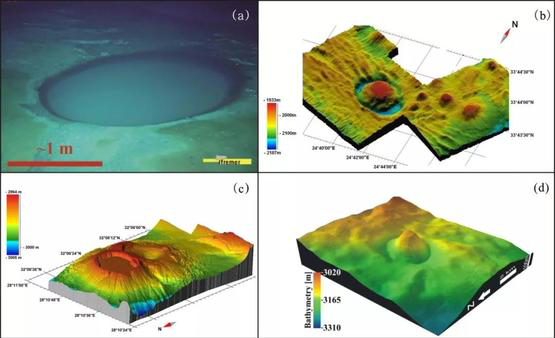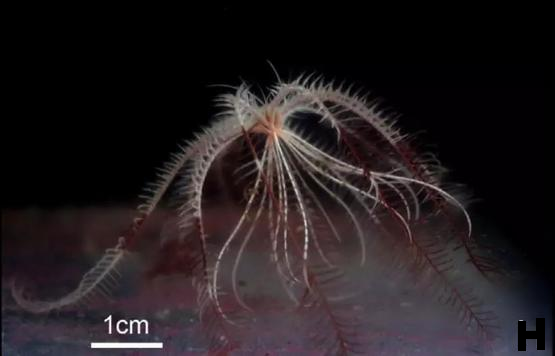谈起火山,相信大家都很熟悉,比如夏威夷的活火山摩那劳,日本的富士山,中国的长白山和五大连池火山。但是提到泥火山,估计就有很少人知道。
I believe everyone is familiar with volcanoes, such as Hawaii’s active volcano Mauna Lo, Japan’s Mount Fuji, China’s Changbai Mountain and Wudalianchi volcano. But when it comes to mud volcano, it is estimated that there are few people know it.
泥火山顾名思义会喷泥浆的火山。与我们熟知的喷岩浆的火山不同的是,它的喷发物是由黏土、角砾岩、地层水等,同时还存在部分的甲烷、二氧化碳和硫化物等气体。泥火山不仅存在于陆地上,海底也存在。我们称之为海底泥火山。
Mud volcano, as the name implies, can spew mud. Unlike the volcanoes we know as magma spewing volcanoes, the eruptions are made of clay, conglomerate, ground water, methane, carbon dioxide, and sulfide gases. Mud volcanoes exist not only on land but also on the sea floor, and we also call them submarine mud volcanoes.
海底泥火山的形成为两个过程。首先泥火山直接发育在海底,或流体刺穿泥底劈后器泥底劈向海底运移,接着流体沿断层或裂缝向上运移或渗漏到海底形成泥火山。研究人员通过多波束测深系统,高分辨率地震等技术手段,发现了这些海底泥火山通常呈圆丘状凸起于海底。
The formation of submarine mud volcanoes is a twofold process. Mud volcanoes develop directly on the seafloor, or fluids pierce the shale detachment and then transport the shale detachment to the seafloor, and then fluids transport or leak upward along faults or fractures to form mud volcanoes. Researchers have discovered that these submarine mud volcanoes are usually raised on the seafloor in the shape of a mound through multibeam bathymetry systems, high-resolution seismic and other technical means.

图1(a)地中海的Napoli泥火山上某喷口的海底摄像;(b)地中海的Napoli泥火山高50m,直径1km; (c)埃及大陆边缘的“双子泥火山“;(d)加迪斯湾的泥火山,高约100m,直径约1km(图片来源:参考文献[1][2])
与陆地泥火山相比,海底泥火山通常也具有喷发和活动特征。人们发现,在海底泥火山喷发物中富含大量的甲烷,其甲烷的排放具有多尺度叠加和强烈的时间变化特征。一般泥火山的演化划分三个阶段,分别为喷发期、平静期和消亡期。而甲烷的排放主要发生在喷发期和平静期。处于喷发期单个泥火山可能在几小时内快速释放多达几千吨的甲烷[3]。研究者们发现,在墨西哥湾、黑海、地中海海岭和鄂霍次克海等地,常可见甲烷泄露到海水中形成的羽状气泡流,说明了这里蕴含了丰富的天然气水合物资源[3,4]。目前石油资源的日益枯竭,寻求高效可持续能源迫在眉睫,海底泥火山中蕴含着天然气水合物资源成为了替代石油资源的候选者之一。
Compared with terrestrial mud volcanoes, submarine mud volcanoes are usually eruptive and active. Methane emissions from mud volcanoes have been found to be highly enriched in methane characterized by multi-scale superposition and strong temporal variability. The evolution of mud volcanoes is generally divided into three phases, namely eruption phase, quiescence phase and extinction phase, and the methane emission mainly occurs during the eruption phase and the quiescence phase. A single mud volcano during the eruption phase can rapidly release up to several thousand tons of methane in several hours. Researchers have found that bubble plumes of methane leaking into seawater are often seen in the Gulf of Mexico, Black Sea, Mediterranean Ridge and Okhotsk, indicating the abundance of gas hydrate resources. With the increasing depletion of oil resources, the search for efficient and sustainable energy sources is imminent, and gas hydrate resources contained in submarine mud volcanoes are one of the candidates to replace oil resources.
海底泥火山喷发物中的甲烷不仅仅可以作为能源使用,它也可以为周围的化能自养型微生物提供充足的能量。人们发现,在海底泥火山中也发现了生命群落的存在,这些生物多都是靠“吃”甲烷而生存。例如海底泥火山生态系统中的甲烷氧化古生菌就是通过对甲烷分解而生存。除此之外,在加迪斯湾的海底泥火山中,研究者们也发现了20种新物种。
Methane from submarine mud volcanoes is not only used as an energy source, but also provides sufficient energy for the surrounding chemoautotrophic microorganisms. Life communities have been found in submarine mud volcanoes, and most of the organisms there survive by “eating” methane. For example, methane-oxidizing archaea in submarine mud volcano ecosystems survive by decomposing methane. In addition, researchers have discovered 20 new species in the mud volcanoes of the Gulf of Cadiz.

图2 Pipoca泥火山东南翼的海百合 (图片来源参考文献[5])
近年来,随着海洋调查技术的快速发展,越来越多海底泥火山群被发现。主要的海域有黑海、地中海、巴伦支海、加的斯湾和墨西哥湾等。同时,在我国的台西南盆地、东沙西南海域和中建南盆地也发现了海底泥火山。在2019年6月15日,深度载人深潜器“蛟龙”号在马里亚纳海沟水深5448米至6668米区域发现了多处泥火山和麻坑。这是目前报道的全球最深的泥火山活动区域,也是首次在俯冲板块上发现与洋壳蚀变相关联的流体活动和释放现象[6]。
In recent years, with the rapid development of marine survey techniques, more and more submarine mud volcanic groups have been discovered. The main sea areas are Black Sea, Mediterranean, Barents Sea, Gulf of Cadiz and Gulf of Mexico. Meanwhile, submarine mud volcanoes have also been discovered in the Southwest Taiwan Basin, the southwest sea of Dongsha Islands and the Zhongjian Basin. On June 15, 2019, the deep manned submersible Jiaolong discovered multiple mud volcanoes and pockmarks in the Marianas Trench area at the depth from 5,448 to 6,668 meters, which was the world’s deepest reported mud volcanic activity area and was also the first time that fluid activities and release phenomena associated with oceanic crustal alteration were found on a subduction plate.
海底泥火山是地球赐予我们的百宝箱,它带给我们的不仅是丰富的资源,同时丰富的生物资源也给我们提供了更多宝贵的研究和应用价值。
Submarine mud volcano is a treasure chest given by the Earth, which brings us not only abundant biological resources but also valuable research and applicable value.
参考文献:
[1] Mascle J, Mary F, Praeg D, et al. Distribution and geological control of mud volcanoes and other fluid/free gas seepage features in the Mediterranean Sea and nearby Gulf of Cadiz[J]. Geo-Marine Letters, 2014, 34(2-3):89-110.
[2] Niemann H, Duarte J, Hensen C, et al. Microbial methane turnover at mud volcanoes of the Gulf of Cadiz[J]. Geochimica et Cosmochimica Acta, 2006, 70(21): 5336-5355
[3] 刘杰, 孙美静, 苏明,等. 海底泥底辟(泥火山)对天然气水合物成藏的影响[J]. 地质科技情报, 2015, 34(5):98-104.
[4] 徐翠玲,孙治雷,吴能友,赵广涛,耿威,曹红,张现荣,张喜林,翟滨,李鑫.海底泥火山的甲烷迁移与转化及其对海洋碳输入的影响[J].海洋地质与第四纪地质,2020,40(06):1-13.
[5] Mazzini A, Etiope G. Mud volcanism: An updated review [J].EarthScience Reviews, 2017, 168: 81-112
[6] Du M.,Peng X.,Seyfried Jr W.E.,Ka T.,Guo Z.,Chen S.,Chou I. M.,Li J.,Xu H.. Fluid discharge linked to bending of the incoming plate at the Mariana subduction zone[J]. Geochemical Perspectives Letters,2019
投稿人:李林倩 博士研究生
审核导师:罗强 教授
 公众号
公众号